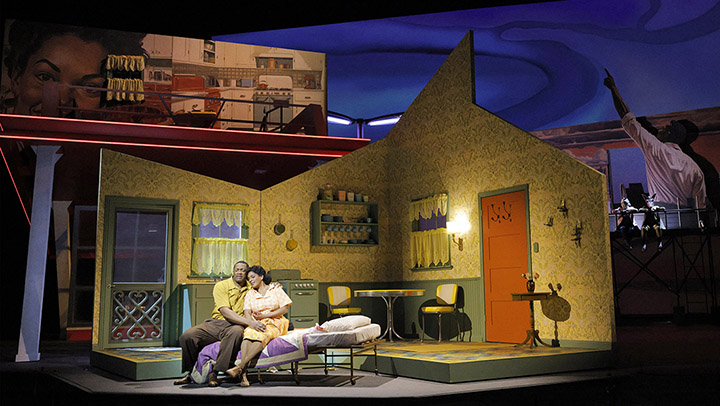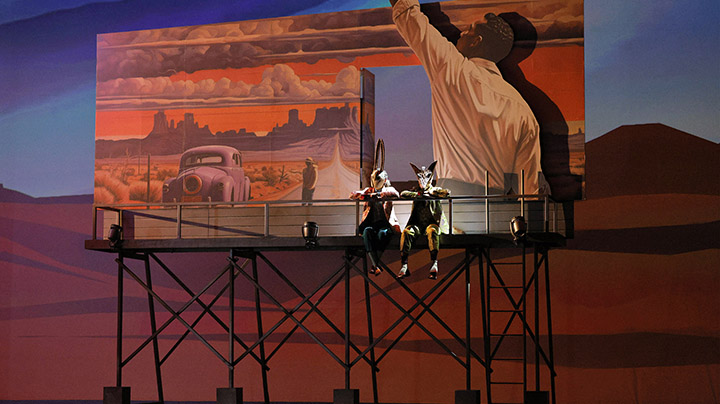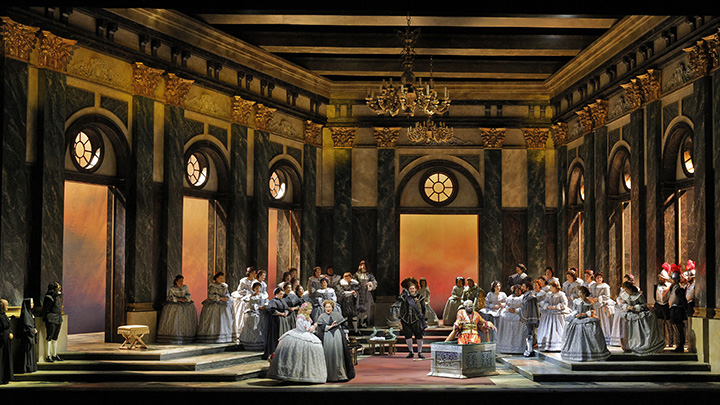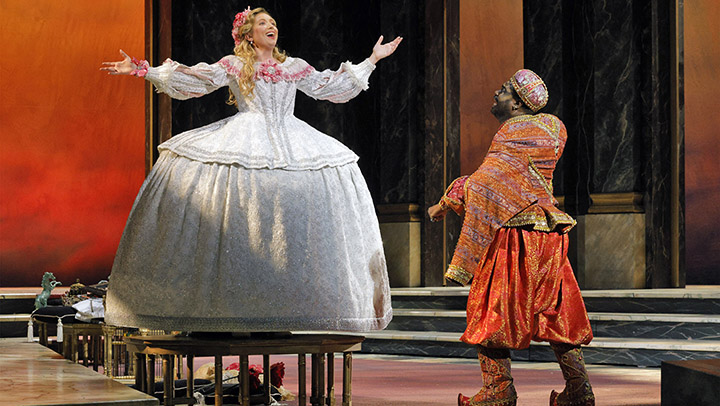
One of the first productions added to our repertoire was Alexander Zemlinky’s Der Zwerg (The Dwarf). Saturday night, we had a long-overdue revival of that work coupled with the local premiere of William Grant Still’s Highway 1, USA.
In his always erudite and informative program notes for both operas he writes,
Aside from these coincidental links, the composers’ deepest indirect bond lies in the fact that their lives were negatively impacted, and the ultimate dissemination of their music blocked to varying degrees by prejudice and political and societal forces. In Zemlinsky’s case, it was literally with genocidal intent, and in Still’s case, metaphorically so. For an unacceptably long period, classical music lovers have been unjustly deprived of the pleasure and inspiration of hearing their music regularly. The time to rectify past wrongs is always now. Both composers, and so many of their compatriots, deserve to be heard. We, the public and musicians, are fortunate to be able to enjoy their very different musical voices.
That coincidental link is the fact that although these two men never met, or probably even knew of each other, they both happened to set the texts of Langston Hughes to music. In Zemlinsky’s case it was with his Symphonische Gesänge. With Still, Hughes was the librettist for his 1939 opera Troubled Island which didn’t receive its premiere until a decade later at the New York City Opera, a historic event on many levels (in spite of the fact that the two original stars played in black-face).
Considered part of the Harlem Renaissance movement, Still conducted the Los Angeles Philharmonic at the Hollywood Bowl in a program of his own works in 1936. Thereby becoming the first African American to conduct a major orchestra in the United States. In spite of winning a Guggenheim Fellowship two years prior to that, he mostly worked as a music arranger in film, radio, and Broadway, and as a guest conductor. His Symphony No. 1 was the most popular piece of music regularly performed by an American composer until the 1950’s (when he was undoubtedly unseated by the works of Leonard Bernstein).
Highway 1, USA was written by Still in the 1940s but not premiered until a Miami music festival in 1963. Still was interested in portraying the lives of real people outside of the stereotypical portrayal of African-Americans in the arts (i.e. by whites). It would also seem to this writer that he was trying for broad appeal just for the opportunity to get his musical voice heard.
LA Opera wisely chose Kaneza Schaal and many of her colleagues, who made Omar such a success here in 2022, as the production team. The set, with its colorful mash-up of Googie architecture and 1950’s television sitcom interiors on movable wagons, offered a variety of playing spaces and perspectives to enliven a story that takes place in a common filling station of that era.
Mary and Bob are the married owners who are supporting the college aspirations of Bob’s spoiled and ungracious (in Mary’s eyes) younger brother Nate. The vocal lines are soaring and Nicole Heaston and Norman Garrett brought strong, and in Ms. Heaston’s case very beautiful, voices to their roles with nuance and conviction. I wasn’t as enamored with Chaz’men Williams-Ali as Nate since I felt he should have been played to be more of a predator as events in the story transpire. Deborah Nansteel provided some touching moments as Mary’s Aunt Lou. Everyone’s diction was crisp and the projected English supertitles were hardly necessary. The problem with the piece is that it was written by someone who’s musical gifts are obviously far greater than the material he’s setting them upon. It’s a 1950’s style melodrama which more than shows its age with a denouement that’s far too pat.
I do want to point out that when I came home to my reference materials (of which I have many) William Grant Still is mentioned in none of them. Plus at the bottom of his Wikipedia page there’s a short list of African-American composers that numbers exactly four. I’m sure there are more, even I know of a few, but it proves indicative of the situation of representation. The list is short for certain but the list of those acknowledged for their contributions is even shorter. If you’re not represented, you don’t exist. Hence his inclusion in this project now.
Maestro Conlon has been a champion of Anton Zemlinsky since he first heard his orchestral fantasy Die Seejungfrau (The Mermaid) on the radio accidentally over 30 years ago. He has since performed and recorded two of his operas and many of his orchestral works.
Zemlinsky enjoyed enormous success as a composer, conductor, and teacher in Europe (he taught Arnold Schoenberg counterpoint) before being first pushed out of Germany and then finally Austria by the Nazis. By the time he came to the United States, he was in ill health, his works neglected. He died four years later in 1942.
The story goes that the composer was, in his late 20’s, besotted with the infamous Alma Schindler. Sadly she broke off their relationship due to Zemlinsky’s physical appearance (she found him, “comical… a caricature, chinless and short”) and his lack of reputation. Ms. Schindler quickly went on to marry Gustav Mahler, by whom she would be widowed less than 10 years later. She then married Walter Gropius (the founder of the Bauhaus Architecture school) while simultaneously carrying on with her eventual third husband Franz Werfel, the playwright, poet, and novelist (primarily remembered today for writing The Song of Bernadette). She, and her breathless love life, are now forever immortalized in the classic Tom Lehrer song, “Alma.”
The upshot of this heartbreak was that Zemlinsky was obsessed with this rejection and it colored many of his future works, not unlike the way Tchaikovsky’s homosexuality informed the enormous and unbearable amount of romantic longing in his music and operas. This adaptation of Oscar Wilde’s short story “The Birthday of the Infanta,” which was itself inspired by Velazquez’s painting “Las Meninas,” brought about Zemlinsky’s most famous opera Der Zwerg (The Dwarf).
Now, hang on, beloveds, because here it starts getting really crazy. Rediscovered by the conductor Gerd Albrecht in 1981 and mounted at the Hamburg State Opera, it was presented with a libretto that was extensively revised by the production’s director Adolf Dresen (with the approval of Zemlinsky’s much younger widow). They also cut 13 minutes of music from an opera that runs just short of 90 minutes (?!) and subsequently made an absolute mish-mash of the visual and musical imagery that the composer was trying to portray. Maestro Conlon was the first to set this all to rights with his live 1997 recording from the Cologne opera which repaired the egregious changes made, especially to the portrayal of the main character, and the missing music.
Then in 2008 LA Opera inaugurated his “Recovered Voices” series with a new production directed by Darko Tresnjak with scenery by Ralph Funicello and costumes by Linda Cho and revived here for the first time since.
The story revolves around the gift of a Dwarf to the young Spanish Infanta on her birthday. The Dwarf comes from mysterious origins and is dressed in noble finery, yet he’s innocent to what he is and only knows that he brings happiness wherever he goes. The Infanta toys with his affections when they’re alone and presents him with a white rose. When she grows tired of his protestations of love, she asks her attendant Ghita to show him his own reflection in a hand mirror. Although Ghita warns him against approaching the throne where she’s left the mirror he eventually looks. Horrified by his appearance he dies from a broken heart clutching the gifted rose. The libretto has all of the underlying perversities that identify Wilde’s works, most especially characters’ misidentifying things in their naming.
I have to say right off the bat that I don’t think I’ve enjoyed a greater representation of an opera both musically and visually. Zemlinky’s music gushed forth from the pit like a perfumed narcotic. The LA Opera Orchestra positively outdid themselves in the most virtuosic playing I think I’ve yet to hear from them. The strings, the horns, and most especially the glittering percussion set the ear aflame under Maestro Conlon’s watchful eye and intense leadership. The chorus of ladies-in-waiting, who unmistakably use the same harmonies as Parsifal’s Blumenmädchen, were absolutely bewitching. The three maids were gloriously sung by Kathleen O’Mara, Deepa Johnny, and Sarah Saturnino, whose praises I have all sung before on these pages in much larger roles.
The Court Chamberlain was the formidable Kristinn Sigmundsson. Emily Magee made her company debut in the role of Ghita and she was the one touch of human compassion in this heartless story. She still has an imposing technique and the way she held the mirror in the folds of her apron while warning the Dwarf was deeply touching.
Erica Petrocelli was the Infanta in goldilocks curls and a massive gown covered in a million diamonds. It’s a treacherous role which sits high in the voice and requires great beauty of utterance lest her true character come through too soon. Ms. Petrocelli rode all the opulent orchestrations like a thoroughbred and veritably danced through her role.
Rare is the singer who can return to a role sixteen years later as Roderick Dixon did Saturday night and still make an enormous success. While his voice doesn’t have a conventional bloom at the top, it does gain in intensity and his phrasing was extraordinary most especially in his final scene which is a veritable emotional breakdown that draws to a melancholy conclusion at his death.
The sets and costumes used many of Valesquez’s imagery including the grand farthingales for the woman. Tresnjak treated the staging like a grand wind-up music box with everything constantly in motion and every character choreographed down to their fingertips. Complimented by the stunning lighting by Pablo Santiago this may be one of the most opulent theatrical experiences I’ve ever had.
We had extra fun at the intermission when the powers that be left the curtain up during the set change so you could see the vastness of the backstage area while everything was switched out (a nod to the Met Live in HD broadcasts, no doubt, and the scenery shifting is always fascinating to watch). They brought the show curtain down just in time so that there was still a gasp from the audience with the start of the second half.
Another fascination is how the cultural make-up of the LA opera audience changes substantially based on the programming. When Javier Camarena gives a recital or at the recent Frida Khalo evening our Latinx population was out in force. The night Anna Netrebko gave her gala concert you’d have thought the population of Los Angeles was half Russian. So it was Saturday night at the Music Center, as with Omar last year, when the African-American community came to support and hear new music. It gives me hope for further audiences across the whole spectrum and I’m glad they were treated to such a fine evening of theatre and music making.
Photos: Cory Weaver/LA Opera





























Comments